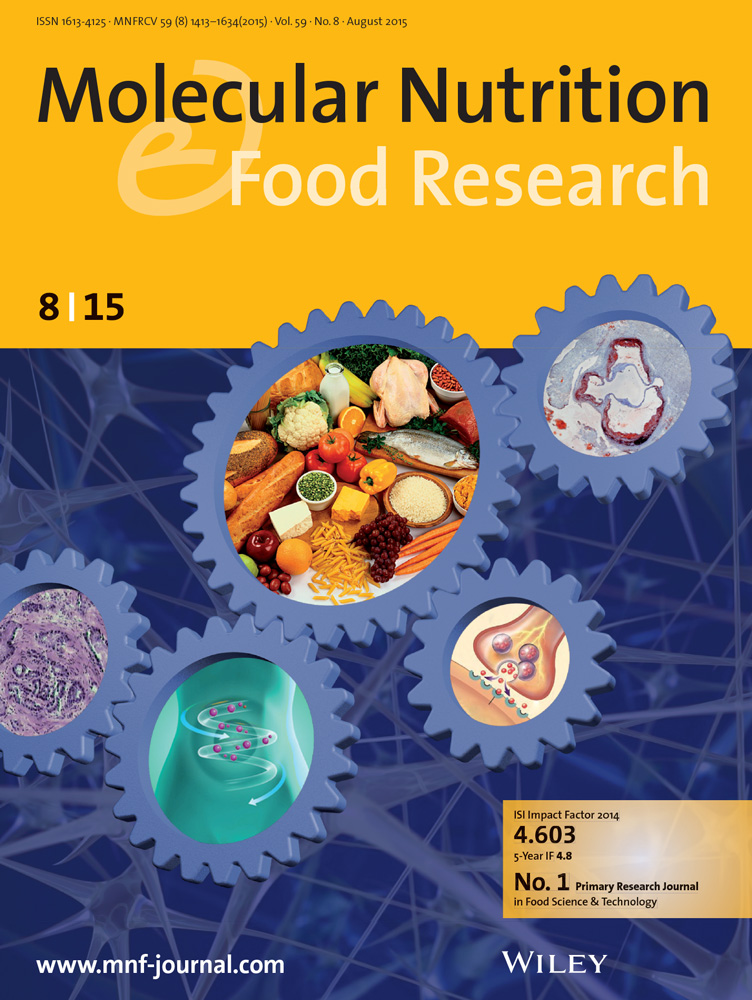白细胞介素17A加剧高盐诱导的高胆固醇血症的发展
IF 4.2
2区 农林科学
Q1 FOOD SCIENCE & TECHNOLOGY
引用次数: 0
摘要
本研究旨在探讨膳食盐影响血压和胆固醇稳态的分子机制。我们给Dahl盐敏感(SS)大鼠喂食高盐饮食(8% NaCl, HSD) 5周,建立了高血压和高胆固醇血症模型。该饮食方案成功诱导高血压并增加血清TC和LDL - C。RNA‐seq和RT‐qPCR分析证实,HSD激活肝脏组织中的胆固醇生物合成导致血清胆固醇水平升高。体内实验表明,HSD诱导的血清IL - 17升高可能是高血压和血脂异常的共同致病因素。HepG2细胞和HUVECs中IL - 17RA的敲低或过表达进一步证实,上调该信号通路可促进SREBP2(一种对胆固醇生物合成至关重要的蛋白)进入细胞核。在HUVECs中,IL - 17RA抑制增强NO的产生,而IL - 17RA过表达则抑制NO的产生。大鼠特异性抗IL - 17A抗体可显著降低盐诱导的高血压,降低血清TC和LDL - C水平。这些发现表明,高盐饮食通过激活IL - 17信号通路增加高血压和高胆固醇血症的风险。这表明IL - 17A抑制剂可能作为治疗盐诱导的高血压和高胆固醇血症的潜在治疗剂。本文章由计算机程序翻译,如有差异,请以英文原文为准。
Interleukin‐17A Exacerbates the Development of High‐Salt‐Induced Hypercholesterolemia
This study aimed to investigate the molecular mechanisms through which dietary salt affects blood pressure and cholesterol homeostasis. We established a hypertension and hypercholesterolemia model via feeding a high salt diet (8% NaCl, HSD) to Dahl salt‐sensitive (SS) rats for 5 weeks. This diet regime successfully induced hypertension and increased serum TC and LDL‐C. RNA‐seq and RT‐qPCR analyses confirmed that activation of cholesterol biosynthesis in liver tissues by an HSD led to elevated serum cholesterol levels. In vivo experiments suggested that the HSD‐induced elevation of serum IL‐17 likely contributes to hypertension and dyslipidemia as a co‐pathogenic factor. Knockdown or overexpression of IL‐17RA in HepG2 cells and HUVECs further confirmed that upregulating this signaling pathway promotes the nuclear entry of SREBP2, a protein critical to cholesterol biosynthesis. In HUVECs, IL‐17RA inhibition enhanced NO production, whereas IL‐17RA overexpression suppressed it. Administration of rat‐specific anti‐IL‐17A antibody significantly attenuated salt‐induced hypertension and reduced serum TC and LDL‐C levels. These findings demonstrate that a high‐salt diet elevates the risk of hypertension and hypercholesterolemia by activating IL‐17 signaling pathway. This suggests that IL‐17A inhibitors may serve as potential therapeutic agents for treating salt‐induced hypertension and hypercholesterolemia.
求助全文
通过发布文献求助,成功后即可免费获取论文全文。
去求助
来源期刊

Molecular Nutrition & Food Research
工程技术-食品科技
CiteScore
8.70
自引率
1.90%
发文量
250
审稿时长
1.7 months
期刊介绍:
Molecular Nutrition & Food Research is a primary research journal devoted to health, safety and all aspects of molecular nutrition such as nutritional biochemistry, nutrigenomics and metabolomics aiming to link the information arising from related disciplines:
Bioactivity: Nutritional and medical effects of food constituents including bioavailability and kinetics.
Immunology: Understanding the interactions of food and the immune system.
Microbiology: Food spoilage, food pathogens, chemical and physical approaches of fermented foods and novel microbial processes.
Chemistry: Isolation and analysis of bioactive food ingredients while considering environmental aspects.
 求助内容:
求助内容: 应助结果提醒方式:
应助结果提醒方式:


